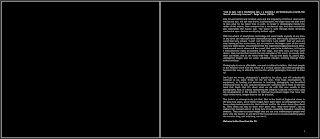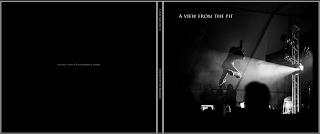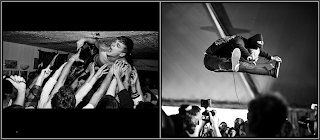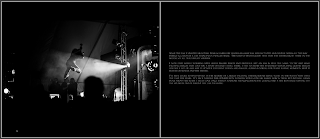See the below link for a PDF of my finished book.
http://philiphardmanphotography.zenfolio.com/aviewfromthepit.pdf
Friday 28 December 2012
Book Introduction
The below text was written as an introduction to my book. I was waiting for an introduction that was going to be written by Georgia Rawson, the editor and owner of a London based music magazine who also photographs bands. She was also going to contribute some images for the book, unfortunataly she has had too much on to so she hasn't contributed either the introduction or any images. This has held up a few things and has also meant that I only have three contributors as apposed to four.
I ended up writing the introduction myself, I felt it was quite fitting as I was the one who put most, if not all, of the work in to it. I am hoping that if I were to do another book with the same concept (A View From The Pit 2), then maybe I would get someone else to write the foreward extrapalating on my concept.
"I am an eye. I am a mechanical eye. I, a machine, I am showing you a world, the likes of which only I can see” - Dziga Vertov (1919).
Skip forward almost one hundred years and the singularity of Vertov's clear-seeing mechanical eye, the eye that shows, is all but gone. No longer does one man show to man what he has taken time to craft, no longer is photography merely the realm of the artistic. Now everyone has a mechanical eye. And that mechanical eye supersedes the human eye. The world is seen through these all-seeing mechanical eyes. And we are all privy to their sights.
With the advent of smartphone technology and social media anybody at any show in any town can hold aloft their mechanical eye and then loudly proclaim to the world that very instant, “Look! I am here! Here I am! LOOK!’ And yet what are they looking at? Not at the show, but at a machine. No longer a part of the crowd they now stand alone, disconnected from the experience happening around them. I look around now at shows and the crowd, that used to be in darkness, is lit up by a thousand tiny lights all pointed at the stage. And then they use that same device, that machine that records the very minutiae of the event, to casually book their taxi home. And so the world wide web fills up with badly lit, poorly shot, unimagined images and we waste unfulfilled minutes scrolling through these artless artifacts.
Photography is now so affordable, now such a cultural leviathan, that most people in the Western world hold the means to it in their pocket. But when photography becomes this easy to afford do we lose the artistic philosophy that used to drive it?
Don’t get me wrong, photography’s popularity has done, and will undoubtedly continue to do, great things for the art form. From huge developments in equipment, to funding and advances in teaching, photography has benefited enormously from its new cultural standing and I certainly don’t mean to bite the hand that feeds. But it’s about what we do with this new wealth in the photographic field. It’s about maintaining the integrity it started with whilst using the developments in the industry to continue to produce images that have real value in the world, images that we can be proud of.
This book is an attempt to do just that. Shot in the South of England at shows in the past two years, all of these images have been taken by photographers who have a deep seated passion for their artform and for the music shows they shoot at. They shoot not only to show their peers that “they were there”, but to capture the moment and in so doing turn it into something beautiful, something timeless. They seek to create images that are not only interesting to people who know who the band is or are fans of the musicians but to reveal something about the world as they, and only they, can see it.
Welcome to the View from the Pit.
I ended up writing the introduction myself, I felt it was quite fitting as I was the one who put most, if not all, of the work in to it. I am hoping that if I were to do another book with the same concept (A View From The Pit 2), then maybe I would get someone else to write the foreward extrapalating on my concept.
"I am an eye. I am a mechanical eye. I, a machine, I am showing you a world, the likes of which only I can see” - Dziga Vertov (1919).
Skip forward almost one hundred years and the singularity of Vertov's clear-seeing mechanical eye, the eye that shows, is all but gone. No longer does one man show to man what he has taken time to craft, no longer is photography merely the realm of the artistic. Now everyone has a mechanical eye. And that mechanical eye supersedes the human eye. The world is seen through these all-seeing mechanical eyes. And we are all privy to their sights.
With the advent of smartphone technology and social media anybody at any show in any town can hold aloft their mechanical eye and then loudly proclaim to the world that very instant, “Look! I am here! Here I am! LOOK!’ And yet what are they looking at? Not at the show, but at a machine. No longer a part of the crowd they now stand alone, disconnected from the experience happening around them. I look around now at shows and the crowd, that used to be in darkness, is lit up by a thousand tiny lights all pointed at the stage. And then they use that same device, that machine that records the very minutiae of the event, to casually book their taxi home. And so the world wide web fills up with badly lit, poorly shot, unimagined images and we waste unfulfilled minutes scrolling through these artless artifacts.
Photography is now so affordable, now such a cultural leviathan, that most people in the Western world hold the means to it in their pocket. But when photography becomes this easy to afford do we lose the artistic philosophy that used to drive it?
Don’t get me wrong, photography’s popularity has done, and will undoubtedly continue to do, great things for the art form. From huge developments in equipment, to funding and advances in teaching, photography has benefited enormously from its new cultural standing and I certainly don’t mean to bite the hand that feeds. But it’s about what we do with this new wealth in the photographic field. It’s about maintaining the integrity it started with whilst using the developments in the industry to continue to produce images that have real value in the world, images that we can be proud of.
This book is an attempt to do just that. Shot in the South of England at shows in the past two years, all of these images have been taken by photographers who have a deep seated passion for their artform and for the music shows they shoot at. They shoot not only to show their peers that “they were there”, but to capture the moment and in so doing turn it into something beautiful, something timeless. They seek to create images that are not only interesting to people who know who the band is or are fans of the musicians but to reveal something about the world as they, and only they, can see it.
Welcome to the View from the Pit.
Monday 10 December 2012
PDF of current book draft
I have uploaded a PDF version of my book in its current state to my website so it can be viewed online. I used the Print dialog box to do this as it is a free way of saving it, although it doesn't allow you to include the front cover for some reason, it also applies a watermark over the top for obvious reasons.
Saturday 8 December 2012
More layout changes
I have also reconsidered the cover and the title of my book. I have removed the image from the rear cover as I found it to be competing with the front cover for attention, for now I have kept it completely black other than a small piece of text in the middle of the page saying "A collection of Photographic Works", I felt that this gave a small hint as to what was inside but without giving anything away forcing the reader to want more. The cover contain the same image as I have always thought that it lends itself very well to the books concept and it also fits well with the layout, text etc.
Change of layout
After a short session discussing my book layout with my fellow Students and Tutor I have decided to change the layout slightly. I was suggested to me that the text in each section should not be on the same page as an image as it takes something away from the image. I agreed with this and have done away with the page at the end of each section that simply contained the photographers website address and replaced it with the blurb. The website address was making the book feel like more of a editorial piece advertising each photographers work. This was not my intention for the book so removing the websites from sch a prominent position helps. I may still include these on a back page at the end of the book so the reader can find more work by each photographer if they wish but it is not my intent to merely promote businesses.
Subscribe to:
Posts (Atom)






